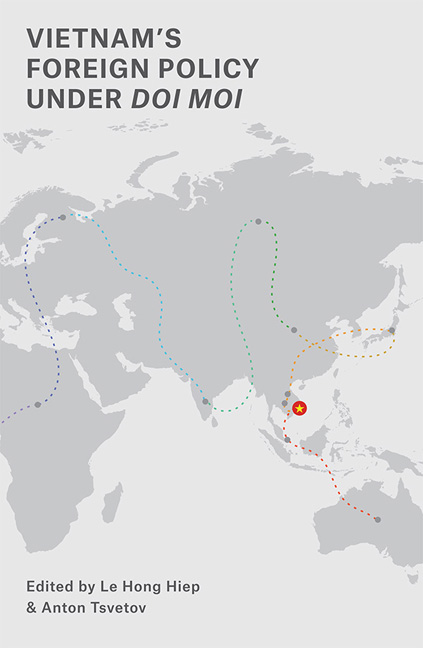Book contents
- Frontmatter
- Contents
- List of Tables
- List of Figures
- List of Abbreviations
- Acknowledgements
- About the Contributors
- PART I ANALYTICAL AND HISTORICAL FRAMEWORK
- PART II BILATERAL RELATIONSHIPS
- 3 The Evolution of Strategic Trust in Vietnam–U.S. Relations
- 4 The 2014 Oil Rig Crisis and its Implications for Vietnam–China Relations
- 5 Vietnam–Japan Relations: Moving beyond Economic Cooperation?
- 6 The Reinvigoration of India–Vietnam Partnership under Prime Minister Modi
- 7 Vietnam–Russia Relations: Glorious Past, Uncertain Future
- 8 Vietnam's Foreign Policy Towards its Smaller Neighbours
- 9 Vietnam's Decision to Join ASEAN: The South China Sea Disputes Connection
- PART III MAJOR FOREIGN POLICY ISSUES
- Index
4 - The 2014 Oil Rig Crisis and its Implications for Vietnam–China Relations
from PART II - BILATERAL RELATIONSHIPS
Published online by Cambridge University Press: 04 July 2018
- Frontmatter
- Contents
- List of Tables
- List of Figures
- List of Abbreviations
- Acknowledgements
- About the Contributors
- PART I ANALYTICAL AND HISTORICAL FRAMEWORK
- PART II BILATERAL RELATIONSHIPS
- 3 The Evolution of Strategic Trust in Vietnam–U.S. Relations
- 4 The 2014 Oil Rig Crisis and its Implications for Vietnam–China Relations
- 5 Vietnam–Japan Relations: Moving beyond Economic Cooperation?
- 6 The Reinvigoration of India–Vietnam Partnership under Prime Minister Modi
- 7 Vietnam–Russia Relations: Glorious Past, Uncertain Future
- 8 Vietnam's Foreign Policy Towards its Smaller Neighbours
- 9 Vietnam's Decision to Join ASEAN: The South China Sea Disputes Connection
- PART III MAJOR FOREIGN POLICY ISSUES
- Index
Summary
In early May 2014, Chinese deep-water oil rig Haiyang Shiyou 981 (HYSY-981), accompanied by around eighty ships, started oil exploration activities at an area off Vietnam's central coast. Vietnam sent naval vessels to the area to prevent the stationing of the rig. Vietnamese authorities also said they would do everything they could to protect the country's sovereign rights and jurisdiction since the HYSY-981 was positioned well within the 200-nautical-mile exclusive economic zone (EEZ) measured from Vietnam's baseline. China responded by claiming that the rig was still inside China's waters measured from the Paracel Islands and within Beijing's maritime claims based on the nine-dash line.
The subsequent standoff, which lasted until July, witnessed a cat and mouse game between maritime law enforcement forces of the two countries, with naval vessels of both sides looming in the background. Chinese ships aggressively rammed and fired water cannons at Vietnamese vessels that were trying to obstruct the rig's operation. The crisis led to two deadly anti-China riots in Vietnam, and created a sense of brinksmanship in the country for weeks. Following the incident, strategic trust between the two countries fell to its lowest point since bilateral normalization in 1991.
The incident further reinforces Vietnam's perception of the China threat in the South China Sea where China has since the late 2000s become increasingly assertive. Over the years, Vietnam has taken various measures to counter China's pressures and to improve its strategic position vis-à-vis China in the South China Sea. In the wake of the crisis, Vietnam has even stronger motivations to step up these efforts and to adjust its domestic as well as foreign policies in anticipation of higher levels of coercion from China in the future.
This chapter analyses the impact of the 2014 oil rig crisis on Vietnam–China relations, focusing on Vietnam's responses to counter the growing threat from China after the crisis. The chapter first reviews the significance of territorial and maritime disputes as a sticking point in bilateral relations. It then details how the 2014 oil rig crisis evolved and discusses mechanisms and diplomatic efforts that Vietnam and China made to mend their relations during and after the crisis.
- Type
- Chapter
- Information
- Vietnam's Foreign Policy under Doi Moi , pp. 72 - 95Publisher: ISEAS–Yusof Ishak InstitutePrint publication year: 2018

